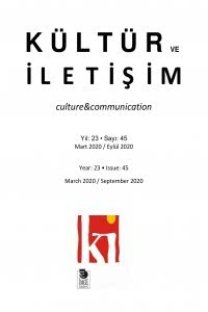Ürün Tasarımı ve Anlam: Gösterge ve Sinyal olarak Nesne
Ürünlerle ilişkimiz onların bizimle nasıl iletişim kurduğuna ve bizim de onları tüm anlamlandırma sistemimiz içinde nasıl konumlandırdığımıza bağlıdır. Ürün tasarımı, birçok kültürel üretim biçiminde olduğu gibi dil bazlı teoriler ışığında analiz edilebilir. Bu önermenin dayandığı ana nokta, eğer böyle bir alımlama varsa, insan eliyle yapılmış herşeyin bir gösterge olarak okunabileceği olasılığıdır. Benzer bir biçimde, farklı bağlamlar içinde her nesne temel iletişim modelinin hem konusu hem de nesnesi olabilir. Bu yazının temel hedefi tasarlanmış ürünün aynı anda nasıl hem iletişim sürecinde sinyal hem de göstergebilimsel anlamlandırma sürecinde gösterge olabildiğinin tartışılmasıdır. İletişim teorileri ve göstergebilim arasındaki temel farkın üstünde durularak, tasarlanmış ürünün nasıl bu iki çalışma alanının konusu olduğu ele alınacaktır.
Anahtar Kelimeler:
gösterge, iletişim ve tasarlanmış ürün, iletişim modelleri
Meaning and Product Design: Towards a Conception of the Object as Sign/al
Our relationship with products depends on how they communicate with us and where we do put them in our entire system of signification. Product design, like most cultural production can be viewed and analysed by language based theories. The basic premise behind this possibility is that every artifact can be read as a sign if there is such a reception. Similarly every artifact can be the subject and object of the signal of the basic communication model in ditterent contexts. The main aim of this paper is to discuss the ways in which the designed product can be the sign of the signification process and the signal of the communication process simultaneously. Emphasizing the ditterence between communication theories and semiotics, the designed product is discussed as the subject of both areas of inquiry
Keywords:
signification system, meaning and language, communication models,
___
- Baudrillard, Jean (1981). For a Critique of the Political Economy of the Sign. Trans., Charles Levin. USA: Telos Press.
- Baudrillard, Jean (1996). The System of Objects. Trans, James Benedict. London: Verso.
- Colon, Carlos (1996). "Communication Science vs. Semiotics." http://ezinfo.ucs.indiana.edu/*ccolon1.html. (11 April).
- Eco, Umberto (1976). A Theory of Semiotics. Bloomington: Indiana University Press.
- Fiske, John (1990). Introduction to Communication Studies. New York: Routledge.
- Fry, Anthony (1988). Design History Australian: A Source Text in Methods and Resources. Sydney: Hale & Iremonger Pty Ltd.
- Gottdiener, Mark (1995). Postmodern Semiotics: Material Culture and the Forms of Postmodern Life. Oxford: Basil Blackwell Ltd.
- ISSN: 1301-7241
- Yayın Aralığı: Yılda 2 Sayı
- Başlangıç: 1998
- Yayıncı: İmge Kitabevi Yayınları
Sayıdaki Diğer Makaleler
Amerika' da Eğitim Dili Politikaları ve "Öteki" Diller
Ötekinin Söylemi ya da Öznenin Lacancı Algılanışında Dil
International Communication Association Toplantısı
Ürün Tasarımı ve Anlam: Gösterge ve Sinyal olarak Nesne
